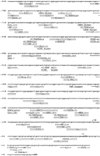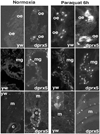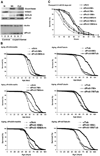Peroxiredoxin 5 confers protection against oxidative stress and apoptosis and also promotes longevity in Drosophila
- PMID: 19128239
- PMCID: PMC2842572
- DOI: 10.1042/BJ20082003
Peroxiredoxin 5 confers protection against oxidative stress and apoptosis and also promotes longevity in Drosophila
Abstract
Peroxiredoxin 5 is a distinct isoform of the peroxiredoxin gene family. The antioxidative and anti-apoptotic functions of peroxiredoxin 5 have been extensively demonstrated in cell culture experiments. In the present paper, we provide the first functional analysis of peroxiredoxin 5 in a multicellular organism, Drosophila melanogaster. Similar to its mammalian, yeast or human counterparts, dPrx5 (Drosophila peroxiredoxin 5) is expressed in several cellular compartments, including the cytosol, nucleus and the mitochondrion. Global overexpression of dPrx5 in flies increased resistance to oxidative stress and extended their life span by up to 30% under normal conditions. The dprx5(-/-) null flies were comparatively more susceptible to oxidative stress, had higher incidence of apoptosis, and a shortened life span. TUNEL (terminal deoxynucleotidyl transferase-mediated dUTP nick-end labelling) analysis revealed that the dprx5(-/-) null mutant had discernible tissue-specific apoptotic patterns, similar to those observed in control flies exposed to paraquat. In addition, apoptosis was particularly notable in oenocytes. During development the dPrx5 levels co-varied with ecdysone pulses, suggesting inter-relationship between ecdystreroids and dPrx5 expression. The importance of dPrx5 for development was further underscored by the embryonic lethal phenotype of progeny derived from the dprx5(-/-) null mutant. Results from the present study suggest that the antioxidant and anti-apoptotic activities of dPrx5 play a critical role in development and aging of the fly.
Figures







Similar articles
-
Peroxiredoxin 5 modulates immune response in Drosophila.Biochim Biophys Acta. 2010 Nov;1800(11):1153-63. doi: 10.1016/j.bbagen.2010.06.010. Epub 2010 Jun 28. Biochim Biophys Acta. 2010. PMID: 20600624 Free PMC article.
-
Mitochondrial peroxiredoxins are essential in regulating the relationship between Drosophila immunity and aging.Biochim Biophys Acta Mol Basis Dis. 2017 Jan;1863(1):68-80. doi: 10.1016/j.bbadis.2016.10.017. Epub 2016 Oct 19. Biochim Biophys Acta Mol Basis Dis. 2017. PMID: 27770625 Free PMC article.
-
Mitochondrial peroxiredoxins are critical for the maintenance of redox state and the survival of adult Drosophila.Free Radic Biol Med. 2010 Dec 15;49(12):1892-902. doi: 10.1016/j.freeradbiomed.2010.09.014. Epub 2010 Oct 19. Free Radic Biol Med. 2010. PMID: 20869434 Free PMC article.
-
Beyond ROS clearance: Peroxiredoxins in stress signaling and aging.Ageing Res Rev. 2018 Jul;44:33-48. doi: 10.1016/j.arr.2018.03.005. Epub 2018 Mar 23. Ageing Res Rev. 2018. PMID: 29580920 Review.
-
Longevity and the stress response in Drosophila.Exp Gerontol. 2007 Mar;42(3):153-9. doi: 10.1016/j.exger.2006.09.014. Epub 2006 Nov 15. Exp Gerontol. 2007. PMID: 17110070 Review.
Cited by
-
Beneficial and Detrimental Effects of Reactive Oxygen Species on Lifespan: A Comprehensive Review of Comparative and Experimental Studies.Front Cell Dev Biol. 2021 Feb 11;9:628157. doi: 10.3389/fcell.2021.628157. eCollection 2021. Front Cell Dev Biol. 2021. PMID: 33644065 Free PMC article. Review.
-
Peroxiredoxin alleviates the fitness costs of imidacloprid resistance in an insect pest of rice.PLoS Biol. 2021 Apr 12;19(4):e3001190. doi: 10.1371/journal.pbio.3001190. eCollection 2021 Apr. PLoS Biol. 2021. PMID: 33844686 Free PMC article.
-
Mitochondrial thiols in the regulation of cell death pathways.Antioxid Redox Signal. 2012 Dec 15;17(12):1714-27. doi: 10.1089/ars.2012.4639. Epub 2012 Jun 11. Antioxid Redox Signal. 2012. PMID: 22530585 Free PMC article. Review.
-
Cytoplasmic and Mitochondrial NADPH-Coupled Redox Systems in the Regulation of Aging.Nutrients. 2019 Feb 27;11(3):504. doi: 10.3390/nu11030504. Nutrients. 2019. PMID: 30818813 Free PMC article. Review.
-
Genetics and epigenetics of aging and longevity.Cell Cycle. 2014;13(7):1063-77. doi: 10.4161/cc.28433. Epub 2014 Mar 6. Cell Cycle. 2014. PMID: 24603410 Free PMC article. Review.
References
-
- Wang X, Phelan SA, Forsman-Semb K, Taylor EF, Petros C, Brown A, Lerner CP, Paigen B. Mice with targeted mutation of peroxiredoxin 6 develop normally but are susceptible to oxidative stress. J. Biol. Chem. 2003;278:25179–25190. - PubMed
-
- Wang Y, Feinstein SI, Manevich Y, Ho YS, Fisher AB. Peroxiredoxin 6 gene-targeted mice show increased lung injury with paraquat-induced oxidative stress. Antioxid. Redox Signaling. 2006;8:229–237. - PubMed
-
- Nagy N, Malik G, Fisher AB, Das DK. Targeted disruption of peroxiredoxin 6 gene renders the heart vulnerable to ischemia-reperfusion injury. Am. J. Physiol. 2006;291:H2636–H2640. - PubMed
-
- Li L, Shoji W, Oshima H, Obinata M, Fukumoto M, Kanno N. Crucial role of peroxiredoxin III in placental antioxidant defense of mice. FEBS Lett. 2008;582:2431–2434. - PubMed
-
- Egler RA, Fernandes E, Rothermund K, Sereika S, de Souza-Pinto N, Jaruga P, Dizdaroglu M, Prochownik EV. Regulation of reactive oxygen species, DNA damage, and c-Myc function by peroxiredoxin 1. Oncogene. 2005;24:8038–8050. - PubMed
Publication types
MeSH terms
Substances
Grants and funding
LinkOut - more resources
Full Text Sources
Molecular Biology Databases

